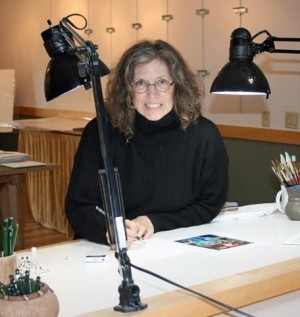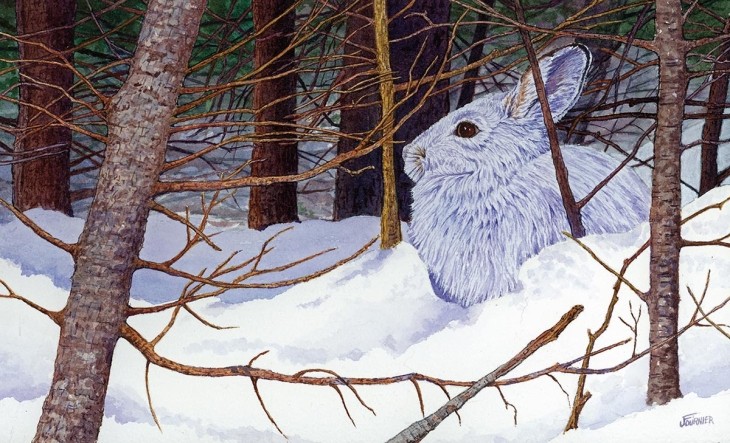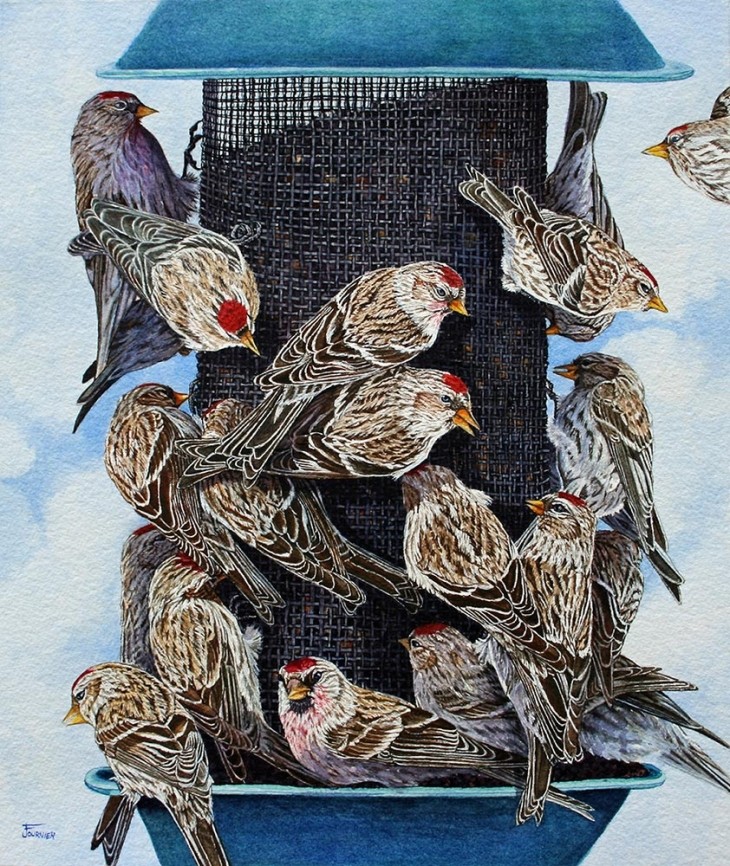
Jeanette Fournier spent much of her childhood in the woods around her home in Littleton, New Hampshire, or filling notebooks with drawings and sketches. Throughout a career in the corporate human resources field, she continued to draw and paint, finding inspiration in the natural world around her – wherever she was. Since moving back to the White Mountains region 15 years ago, Fournier has opened her own studio. She also displays and sells her nature-based watercolor paintings and graphite sketches at galleries in New Hampshire, Vermont, Massachusetts, and Maine, as well as at various art festivals in New England.
I am a child of these northern mountains. I have a sister and two brothers, all close in age, and sometimes I think we were like wild, feral kids. We were always in the woods playing. There was over 100 acres of woods behind our house. There was a large field that a local farmer hayed, and there was just wildlife all over the place. We could roam anywhere we wanted all day long, and when my mother was ready for us to come home, she’d stand on the back porch and ring this giant bell. You could hear it for miles. We’d hear that bell no matter where we were in the woods, and we’d come running. I have that bell now and use it to call my own family in from out of the woods.
The woods behind our house was an amazing playground. We would spend hours and hours out there, building forts and treehouses, looking for birds and wildlife. There were vernal pools to explore, trees to climb, rocky ledges with dark openings to investigate, and old logging roads. We would run all around on those roads and have sled races in the winter. I mean, breakneck, wild sled rides down this steep, steep hill. It’s amazing I’m still alive. You’d hit a hump of snow and be airborne, no way to stop. It was wonderful.
Nature was always a part of our lives. Our parents would take us for picnics up in the Connecticut Lakes region, or for hikes, or fishing. Our mother was very interested in gardening and flowers and birds, just wildlife in general, and instilled those same interests in us. We always had birdfeeders out. We had bluebird houses set up in the field behind the house. We never knew what we were going to see when we looked out the back window: turkeys, deer, moose, bears.
On weekends, and during the summers we were always with my grandparents in Bethlehem. My grandparents lived in one of those great, big Victorian houses right in town, and they also owned Whittier’s White Mountain Museum in Lincoln, which was more of a cabinet of curiosities. There was a room all about old cars, with Model T Fords, another room set up like an old time country store, an area displaying antique toys, a room with a variety of animal heads. There were old calliopes, a player piano, music boxes and other mechanical marvels. My grandfather was a tinkerer. He completely rebuilt an entire carousel. All the kids would come to our house because they’d hear the calliope music playing. It was a wonderfully creative place to grow up.
Even from a very, very young age, art is something I always did. There was a room over our garage, and it was just for us kids. We each had our corner and could do what we wanted. I would spend my time drawing, mostly – colored pencils, regular pencils, whatever I had at hand. I would draw everything and anything I could get my hands on. I copied pictures out of magazines or my story books or comic books. I had notebook after notebook filled with sketches.
I’m self-taught. I didn’t go to art school. I have taken a few classes, but mostly I’ve learned it just from doing it on my own and practicing. When I was younger, I would recreate Norman Rockwell paintings, or Remington drawings, or N.C. Wyeth. I spent a lot of time practicing drawing their work. I really think it made a big difference to learn and develop those skills from a young age. I have really strong drawing skills as a result.
When I start a painting, I will sketch out the animal and the basic details of the background, just to give myself a guideline to follow. With watercolor, you have to work your way from the back forward. It’s not like oil painting, you can’t just paint over it. It’s a very unforgiving medium – if you make a mistake, it stays there, for the most part. Sometimes those mistakes turn out to be “happy accidents,” and others not so much.
My parents encouraged my interest in art, but they really wanted me to go to college and get a business degree and do something practical. And I did, which actually in the long run has been very helpful to me. Even once I finished with college and went off into the work world and got a job in the corporate environment, I always continued to draw and paint on my own. When I did start my studio business, I think all my experience in the business world came in very handy.
Everything I’ve done has always been related to wildlife and birds and nature. That’s always been my focus and something that I love. Several years ago, I bumped into a woman who was the president of an art organization out of Boston, and she gave me some really good advice: Paint what you see, paint what you know, and paint what you love. I’m lucky enough that I live in such a beautiful place and have the opportunity to see a lot of wildlife. Most of the places I have lived, there has always been some wild place that I could go to see things.
I’ve had a camera in my hand since I was in high school. When I’m out and about I’ve always got my camera with me, in case I see something I want to use as reference material in my artwork. Most of my artwork is a combination of the reference photos I take and my imagination. If I can get a nice clear picture of the animal or the bird, then I can use my imagination to fix the lighting or change the setting or do something different with it.
Sometimes I go to places like the Vermont Institute of Natural Science in Quechee or the Squam Lakes Natural Science Center, because it can be difficult to see or find some of the wildlife I paint. Squam has a winter wildlife walk, and it’s so much fun and so interesting to see the animals in the winter setting. I see bobcats in the summer here (at home), but one year I really wanted to get pictures of bobcats with their full winter coats, so I went to Squam Lakes for the winter wildlife walk, because that was the only way I was going to see one.
I always make a goal for myself at the beginning of the summer about what I want to photograph. I’ll pick something that I really don’t have a lot of good pictures of to use for reference materials. If I know where wildlife’s coming in and what time of day they’re going to be there, I’ll set up my camouflage tent and sit in there with my camera and wait for them to come. It can take a long time; I can sit in this tent for hours sometimes, all to get a single photo of something so I can have it for a painting. But it’s always worth it when I get the money shot.
Really, I love all the animals I paint. I’ll paint a cardinal and think, “This is one of my favorite birds.” And then I’ll paint a bluebird and think, “This is my favorite bird.” If I had to pick one thing, I guess I would pick owls. I think they’re beautiful, and maybe it’s the fact that we don’t see them that often, so when you do see one it’s really exciting. It’s not just me who likes them. I keep painting them, and people keep buying them.
One of the things I hear all the time from people at art shows is, “Oh, I just saw my first moose.” And they’ll buy a painting of my moose because it reminds them of that moment. Or they have a favorite bird that they really love. For a lot of people, it’s more of a spiritual thing, they just have a connection with a certain bird or animal and buy a painting for that reason.
I also practice archery. I picked it up in high school – they offered it, believe it or not, in gym class – and I really enjoy it. I have a big square target that my husband got for me. If I’m having a difficult day or having trouble with a painting or I just need to take a break, I’ll go out with my bow and fire off a few arrows into the target. I find it really soothing. It calms my mind down if I’m restless, and it’s just fun.
Since I moved back 15 years ago, and especially this year with Covid, I’ve noticed there are just more people everywhere. It’s so congested. I’ve also noticed that I see fewer and fewer animals and birds – things I used to see a lot of, like snowshoe hare and moose, and now I hardly see anymore. But on a good note, I also have seen organizations like ACT (Ammonoosuc Conservation Trust), New Hampshire Audubon, and the Forest Society doing a lot to help preserve our wild spaces to make sure that there are still places that are wild. And not just forests, but farms and big open fields and meadows.





